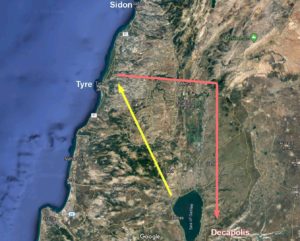The Ministry of Jesus in Galilee
Mark 1:16—8:30
A New King (1:16—3:6).
Kingdom is Near (1:15)
Popularity (1:16-45).
Conflict (2:1—3:6).
Jewish Leaders Reject Him (3:6)
A New Kingdom (3:7—6:6)
Kingdom Has Small Beginnings (4:3)
Continued Conflict (3:7-35).
Parables (4:1-34).
Identity (4:36—6:6).
Jesus’ Town Rejects Him (6:6)
A New Order (6:7—8:21)
Beware of Herod & Pharisees (8:15)
Confession (6:7—8:21).
Limited Commission (6:7-13).
John the Baptist Executed (6:14-29).
Five Thousand Fed (6:30-44).
Jesus Walks on Water (6:45-56).
Opposing Pharisaic Traditions (7:1-23).
Syro-Phoenician Woman (7:24-30).
Location.
Recall, this region was the same area that Jesus healed the man possessed by Legion—He cast the demons out into a herd of swine.
This is another Gentile region, making it even more clear His intentions toward the Gentiles.
The Lord isn’t just the God of the Jews, but the one true God of all.
Jesus moves from Tyre and Sidon to the east side of the Sea of Galilee once again—Matthew says He
 skirted the Sea of Galilee (Matt. 15:29).
skirted the Sea of Galilee (Matt. 15:29).His fame had spread there before (3:7-8), especially after Legion was cast out and He encouraged the former demoniac to spread the news (5:19-20).
Unique to Mark.
This is one of two miracles completely unique to Mark.
The other is the healing of a blind man in Mark 8:22-26.
This is also the only recording we have of a specific instance where Jesus heals a deaf man. There are mentions of it elsewhere, but only mentions (Matt. 11:5; Luke 7:22).
Mark is showing how much of a servant Jesus is by helping all these people, rarely ever finding rest.
He was deaf and could not hear.
One thing we might notice about those who are deaf or hearing impaired is that their speech is a little off.
That can’t be helped—we learn how to speak by hearing others around us. If we can’t hear others, speech becomes that much more difficult.
That could be this man’s problem, but he could also have had a stammer, literally to “speak with difficulty.”
Perhaps he was mute entirely, but the text seems to suggest merely a stammer.
Later, the people say that Jesus makes the mute speak—while true, that may have been a slight exaggeration in this case.
Jesus heals him.
The people there brought this deaf man to Jesus, begging Him to put His hand on him and heal him.
Jesus takes him aside. Why do you suppose He took him aside? Perhaps to perform the miracle in more seclusion—He does tell the man not to tell anyone about this. Perhaps it was to avoid the sensory overload this man was about to experience with so many sounds coming from the crowd.
We know Jesus can heal from afar or with the touch of His clothing, yet here He decides to do something seemingly peculiar to heal this man.
He decides to put His fingers in his ears, spit, and touch his tongue.
This won’t be the last time He does something like this, either.
Did Jesus have to heal in this fashion? No, of course not. So He must have done it for a reason. Why do you suppose He did?
Perhaps Jesus wanted to make it clear who was healing him.
This is further shown by looking up to heaven and sighing.
Saliva was thought to have had healing properties among some Gentile peoples, so perhaps He also wanted them to make that connection.
He then spoke Aramaic to this Gentile, “Ephphatha,” perhaps reinforcing that, while He is healing Gentiles, He is still Jewish.
Perhaps this was the first word this deaf man heard. It was as if Jesus were hinting that this man needed to look toward the Jews for salvation—after all there is no mention that his faith made him well as at other times.
His ears were opened and he could speak plainly—again it happened immediately.
The reaction.
Jesus had taken the deaf man aside—perhaps only those who brought him were with them, as Jesus addresses them now.
He urges them to tell no one of this, and, as before (1:44-45), they did not listen.
This was contrary to what He told the demoniac in Mark 5. Why?
Perhaps He didn’t want His fame to spread too fast too soon.
This could hasten His crucifixion before He was ready—more teaching and healing to do!
Or it would serve to prevent Him from finding any rest—we know He has been desperate for a respite, but finding none.
Whatever the case, they proclaim it further because they were astonished. As one commentator put it, their minds were blown!
What they proclaim is that He has done all things well!
They also echo what Isaiah prophesied concerning Jesus in Isa. 35:5-6.


